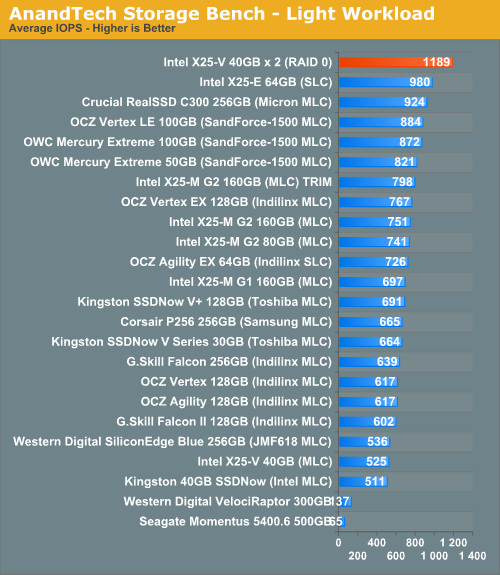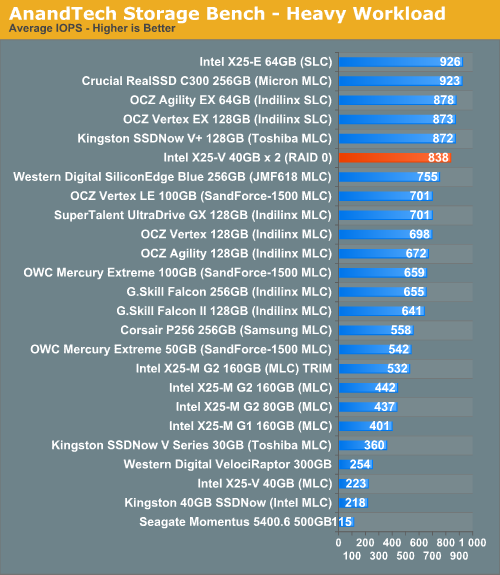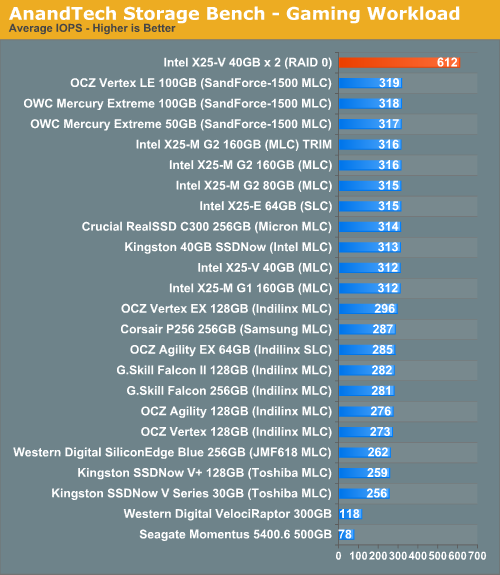Intel X25-V in RAID-0: Faster than X25-M G2 for $250?
by Anand Lal Shimpi on March 29, 2010 8:59 PM ESTAnandTech Storage Bench
The first in our benchmark suite is a light usage case. The Windows 7 system is loaded with Firefox, Office 2007 and Adobe Reader among other applications. With Firefox we browse web pages like Facebook, AnandTech, Digg and other sites. Outlook is also running and we use it to check emails, create and send a message with a PDF attachment. Adobe Reader is used to view some PDFs. Excel 2007 is used to create a spreadsheet, graphs and save the document. The same goes for Word 2007. We open and step through a presentation in PowerPoint 2007 received as an email attachment before saving it to the desktop. Finally we watch a bit of a Firefly episode in Windows Media Player 11.
There’s some level of multitasking going on here but it’s not unreasonable by any means. Generally the application tasks proceed linearly, with the exception of things like web browsing which may happen in between one of the other tasks.
The recording is played back on all of our drives here today. Remember that we’re isolating disk performance, all we’re doing is playing back every single disk access that happened in that ~5 minute period of usage. The light workload is composed of 37,501 reads and 20,268 writes. Over 30% of the IOs are 4KB, 11% are 16KB, 22% are 32KB and approximately 13% are 64KB in size. Less than 30% of the operations are absolutely sequential in nature. Average queue depth is 6.09 IOs.
The performance results are reported in average I/O Operations per Second (IOPS):

That's right. A pair of X25-Vs in RAID-0 offers better performance in our light workload than Crucial's RealSSD C300, a $799 drive. The performance scaling is more than perfect, but that's a side effect of the increase in capacity. Remember that Intel's controller uses any available space on the SSD as spare area to keep write amplification at a minimum. Our storage bench is based on a ~34GB image, which doesn't leave much room for the 40GB X25-V to keep write amplification under control. With two our total capacity is 74.5GB, which is more than enough for this short workload. With the capacity cap removed, the X25-Vs can scale very well. Not nearly twice the performance of an X25-M G2, but much faster than a single drive from Intel.
If there’s a light usage case there’s bound to be a heavy one. In this test we have Microsoft Security Essentials running in the background with real time virus scanning enabled. We also perform a quick scan in the middle of the test. Firefox, Outlook, Excel, Word and Powerpoint are all used the same as they were in the light test. We add Photoshop CS4 to the mix, opening a bunch of 12MP images, editing them, then saving them as highly compressed JPGs for web publishing. Windows 7’s picture viewer is used to view a bunch of pictures on the hard drive. We use 7-zip to create and extract .7z archives. Downloading is also prominently featured in our heavy test; we download large files from the Internet during portions of the benchmark, as well as use uTorrent to grab a couple of torrents. Some of the applications in use are installed during the benchmark, Windows updates are also installed. Towards the end of the test we launch World of Warcraft, play for a few minutes, then delete the folder. This test also takes into account all of the disk accesses that happen while the OS is booting.
The benchmark is 22 minutes long and it consists of 128,895 read operations and 72,411 write operations. Roughly 44% of all IOs were sequential. Approximately 30% of all accesses were 4KB in size, 12% were 16KB in size, 14% were 32KB and 20% were 64KB. Average queue depth was 3.59.

We see the same super scaling here thanks to the increase in capacity offered by RAIDing two of these drives together. The overall performance is great. We're at around 91% better performance than a single X25-M G2.
The gaming workload is made up of 75,206 read operations and only 4,592 write operations. Only 20% of the accesses are 4KB in size, nearly 40% are 64KB and 20% are 32KB. A whopping 69% of the IOs are sequential, meaning this is predominantly a sequential read benchmark. The average queue depth is 7.76 IOs.

As we saw in our sequential read tests, the X25-Vs in RAID-0 can do very well in sequential read workloads. Our game loading test has the X25-V RAID array beating even Crucial's 6Gbps RealSSD C300.










87 Comments
View All Comments
GullLars - Thursday, April 1, 2010 - link
I think TRIM works i IDE mode also, i remember reading that both drivers PCIIDE and MSAHCI supports TRIM. However, this is not the big problem with using IDE mode, the problem is the loss of NCQ, so your performance don't scale with load. Your SSD will essentially only be able to do about 20MB/s at 4KB random read, while it can do 120MB/s random read with NCQ enabled (at fairly high load, like launching multiple apps simultaneously).buzznut - Thursday, April 1, 2010 - link
Thanks for the reply. I have been considering getting a new mobo anyway, I think I'd like to get a 890gx with the new interfaces.Only pb there is I have ddr2 ram and am2 cpus. doh
Guess I'll wait til some money comes in to do any upgrading...
Elganja - Friday, April 2, 2010 - link
"Update (03/29/2010): Intel has recently released a new driver that allows Windows 7’s TRIM instructions to be passed through the Southbridge. The new driver is labeled "Rapid Storage Technology 9.6" and it can be found here. These drivers are also able to pass TRIM commands to RAID 0 and RAID 1 arrays. "jed22281 - Saturday, April 3, 2010 - link
TT is mistaken, there is no support for drives combined into RAID volumes.There is for individual drives connected to the controller while it's in RAID mode.
http://www.intel.com//support/chipsets/imsm/sb/CS-...
Also see
http://communities.intel.com/community/tech/solids...
Look for the gold star at the top of the page, select show details and then go to announcement 2.
"Intel® RST 9.6 supports TRIM in AHCI and pass through modes for RAID. A bug has been submitted to change the string that indicates TRIM is supported on RAID volumes (0, 1, 5, 10). Intel is continuing to investigate the ability of providing TRIM support for all RAID volumes in a future release."
Chloiber - Sunday, April 4, 2010 - link
A colleague from another HW site asked Intel directly. It's definitely NOT SUPPORTED (just to point that out again). It's clearly a mistake of intel, as they didn't make themselves clear in the change logs/readmes and even in the rapid storage manager itself it's not clear.Here is what they said btw:
"It will support TRIM with SSDs in an AHCI configuration, or with the RAID controller enabled and the SSD is used as a pass through device. An example of this use case is for users that want to use the SSD as a boot drive but still be able to RAID multiple HDDs together to allow for large protect data storage – a great use for the home theater PC."
No RAID0 or anything. "Just" simple TRIM as we're used to from the MSAHCI drivers.
Elganja - Friday, April 2, 2010 - link
The quote was from this article: http://www.tweaktown.com/articles/3116/tweaktown_s...morphin1 - Friday, April 2, 2010 - link
What do you mean by doing sequential write?How would you do that?
Also will this apply to the new Sony Vaio Z series laptops SSD's that come in Raid 0 config?
Is it recommended to buy a laptop in Raid 0 config with SSD's as over time they might become snails.
Do you see the chance of Trim being supported on current SSD's in the near future?
Thanks a lot in advance.
GullLars - Saturday, April 3, 2010 - link
Sequential writes are the type of writes that typically occur when you save or copy large files (1MB or larger).As for RAID in sony Vaio. There is no way of telling if it will become snail-like whitout knowing wich SSD is in the laptop in question. If it's Intel, Sandforce, or C300, it sould be just fine, if it's some low-quality cheap SSD from last generation drives, or the crap they put in the netbooks last year, it will go really bad.
jed22281 - Saturday, April 3, 2010 - link
You mean if it's:Postville (Intel), SF-1200/1500 (Sandforce), C300 (JMicron), or Barefoot (Indilinx)
GullLars - Saturday, April 3, 2010 - link
I forgot barefoot, my bad.